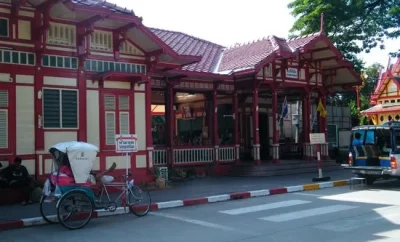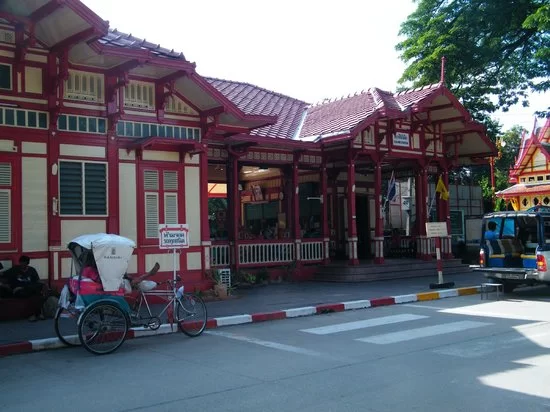Hua Hin Railway Station

The Hua Hin Railway Station: A Journey Through History and Architectural Charm
The Hua Hin Railway Station stands as a poignant reminder of a bygone era in Thailand’s beloved coastal resort town. More than just a transportation hub, this iconic structure is a living testament to the Kingdom’s railway development and the foresight of its royal patrons. Its distinctive design and historical significance draw visitors and history enthusiasts alike, offering a glimpse into the golden age of Hua Hin’s transformation from a quiet fishing village to a sophisticated royal retreat. This article delves into the rich history and captivating design elements that make the Hua Hin Railway Station a must-see landmark.
The station’s origins are deeply intertwined with the expansion of Thailand’s railway network during the early 20th century. Commissioned as part of the southern railway line extension, its construction marked a significant milestone in connecting Bangkok with the southern provinces. The vision was to create a convenient and elegant gateway for the royal family and visiting dignitaries to access Hua Hin, which was rapidly gaining popularity as a seaside destination. This royal patronage would indelibly shape the station’s character and its place in the town’s identity.
From its early days as a bustling transit point for royalty and vacationers to its enduring role today, the Hua Hin Railway Station has witnessed decades of change and development. Its architectural style, a blend of traditional Thai and colonial influences, reflects the era of its creation and has been meticulously preserved, offering a unique aesthetic that sets it apart from modern railway facilities. Exploring the history and design of this station is not just about understanding a building, but about appreciating a pivotal piece of Thai heritage.
A Royal Vision: The Birth of Hua Hin’s Railway Hub
The story of Hua Hin’s railway hub begins in a time of great change for Thailand. The early 20th century saw the nation embracing modern infrastructure. Building a strong railway network was a key part of this progress. Connecting Bangkok to the southern parts of the country was a strategic goal for the government. The Hua Hin Railway Station is beautiful to visit and travel from.
The Southern Line Extension and Hua Hin’s Rise
The State Railway of Thailand worked hard to stretch its lines. They planned to reach further south, aiming to improve travel and trade. The decision to extend the southern line all the way to Hua Hin came from a smart plan. It would make travel easy for the royal family and draw tourists to the coast. This was a big step in linking the capital to a growing seaside haven. Hua Hin Railway Station is located in the heart of the city.
Royal Patronage and Early Development
The Thai monarchy played a direct part in making Hua Hin a special resort town. The Hua Hin railway station was crucial to this vision. It was built with the idea of serving the royal family first, providing them a comfortable and private way to reach their summer palace. This royal connection gave the station a unique charm and importance right from the start.
Architectural Elegance: The Distinctive Design of Hua Hin Station
When you first see the Hua Hin Railway Station, its beauty immediately grabs your eye. It stands out with a style all its own. This design blends different cultures and traditions, making it truly special. It tells a story through its wood, paint, and graceful lines.
Thai-Colonial Fusion: A Unique Aesthetic
People often call the station’s style “Victorian Thai.” It mixes European colonial looks with traditional Thai touches. You can see this in the main building’s wooden parts and the slope of its roof. Wide verandas offer shade, and detailed designs add beauty. This mix shows the artistry of its builders from many years ago. It really sets the Hua Hin Railway Station apart.
The Iconic Red and White Pavilion
The most famous part of Hua Hin Station is its striking red and white main building. Its bright red roof contrasts sharply with the white walls. Inside, you find open waiting areas and ticket counters. This pavilion was originally built to welcome royal guests, offering comfort and style. It is a symbol of the station’s royal past.
Preserving Heritage: Restoration and Maintenance Efforts
Keeping this historic station in good shape takes a lot of work. Over the years, there have been efforts to fix and restore parts of the building. These projects help keep its old charm alive. They also make sure the station can keep working for travelers every day. Its heritage status means it is a treasured piece of Thailand’s past.
A Living Landmark: The Station’s Enduring Role
The Hua Hin Railway Station is much more than just an old building. It still serves a vital purpose in the town. It connects people, invites visitors, and holds a special place in the hearts of locals. Its history is real, alive, and part of everyday life.
Operational Hub: Connecting Hua Hin
Today, the Hua Hin Railway Station remains a busy transport spot. Trains arrive and depart daily, carrying passengers to and from the town. It links Hua Hin to Bangkok and other spots down south. For many, it is still the preferred way to travel, offering a pleasant journey. You can still hop on a train here and explore more of Thailand.
A Tourist Attraction and Photo Opportunity
Even if you don’t ride a train, the station is a must-see. Its beauty makes it a top spot for tourists. People love to take pictures here because of its unique look and lovely setting. It is one of Hua Hin’s most famous landmarks, perfect for capturing travel memories. Do you want a truly classic Hua Hin photo? This is the place.
Cultural Significance and Local Identity
The station is a big part of Hua Hin’s identity. It reminds locals of their town’s royal roots and its growth. It stands as a silent witness to generations of stories. You’ll find it pictured in local art and mentioned in town history. It’s truly a symbol of Hua Hin’s past and present.
Beyond the Tracks: Experiencing the Hua Hin Railway Station
Ready to visit this amazing place? You can make the most of your trip with a few simple tips. The station offers a unique slice of history and a great chance for photos. Get ready to step back in time.
Planning Your Visit
For the best experience, try to visit in the morning. The light is perfect for photos, and it is usually less crowded. The station is easy to find in the heart of Hua Hin. You can get there by car, taxi, or even walk if you’re staying nearby. Just soak in the atmosphere upon arrival.
Exploring the Surroundings
While you’re at the station, take time to see what’s close by. The main Hua Hin beach is a short walk away. You can also find local markets and small cafes nearby. Why not grab a refreshing drink or a local snack while you are exploring? It’s a great way to experience the local scene.
Capturing the Memories
The station is very photogenic. Focus on its red roof and white wooden details. Try different angles to get the best shots. Early morning or late afternoon light often highlights its features beautifully. Capture the trains passing by or the old ticket booth for unique memories.
Conclusion: A Timeless Symbol of Hua Hin
The Hua Hin Railway Station stands as a true treasure. It tells a story of royal visions and Thai progress. Its distinct red and white design, mixing local and colonial styles, makes it unforgettable. More than just a stop for trains, it is a living piece of history. The station continues to connect people while charming everyone who visits. It is a timeless symbol of Hua Hin’s enduring charm and rich past.
Also the Hua Hin railway station is located in central Hua Hin on the west end of Damnoen Kasam Road and easy to walk to if you are in the central Hua Hin Information area.
There are many shops located nearby with all types of Thai food served fresh. Taxis are available to take you wherever you need to go. Lots of fresh seafood restaurants await. There are many great restaurants are located by Hua Hin Beach.
Booking train tickets online can be done through the official SRT website available in Thai or English language, or purchase tickets right at the Hua Hin train station.
Table of Contents
Toggle

